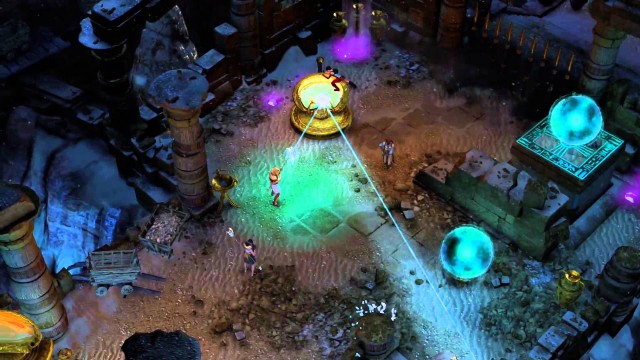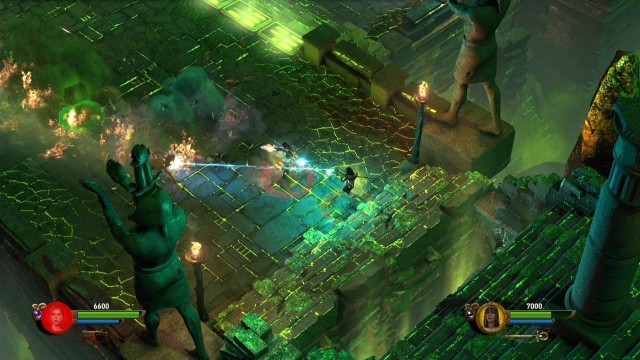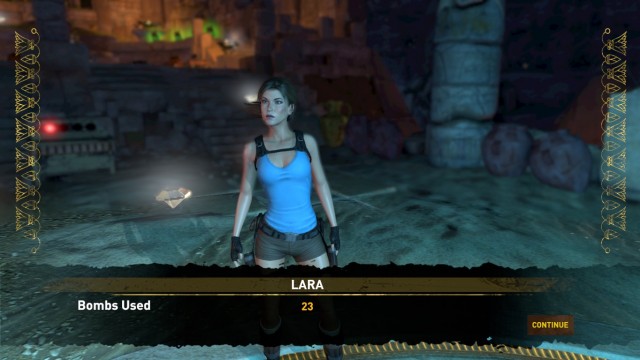When Lara Croft and the Guardian of Light released in 2010, it proved itself a surprising success, with its revised focus on arcade-style shoot ’em up action, yet not at the expense of the puzzle-heavy tomb-romping that the Tomb Raider series had made a name for itself on. Pair that with an effective emphasis on co-op play, and you had a pretty promising formula for taking a triple-A game IP, and condensing it down into something smaller and more accessible for digital download channels, yet no less appealing.
Several years later, Square Enix and Crystal Dynamics have revisited their arcade revamp of Lara Croft’s adventures, 2013 reboot be damned, with Lara Croft and the Temple of Osiris. Upgraded for next-gen hardware, and expanding the player count to a full four, Lara Croft and the Temple of Osiris aims to take the foundation of Lara Croft and the Guardian of Light, and bring it to the next level, with an all-new story and refined gameplay that will once again have spelunkers and plunderers chasing high scores with their friends.
… Except, oddly, Lara Croft and the Temple of Osiris doesn’t totally feel like an upgrade.
For whatever reason, Lara Croft and the Guardian of Light had more depth and replay value than Lara Croft and the Temple of Osiris seems to. Lara Croft and the Temple of Osiris is still a serviceable co-op shoot ’em up, mind you, and it will certainly entertain you and your friends for the handful of hours you’ll spend proceeding through its stages. Beyond that though, the game feels like its improved technology and boosted player count came at the expense of more interesting tombs to explore, and more interesting enemies to fight.
Lara Croft and the Temple of Osiris looks like a satisfactory upgrade of the visual design from Lara Croft and the Guardian of Light, even if the character models and cutscenes leave a bit to be desired.
The modestly-defined models are acceptable enough, though it’s the environments and atmosphere that most effectively sell Lara Croft and the Temple of Osiris. Even if the tombs don’t quite engage players on the same level as those in Lara Croft and the Guardian of Light, the locations still leap off of the screen, feeling eerily ominous and full of cool atmospheric touches, from lifelike water animations to well-rendered flames and earth that constantly beckon you forward, ever-deeper into the realms of the unknown. Even from an isometric viewpoint, exploring the stages of Lara Croft and the Temple of Osiris carries a lot of visual weight, and they at least justify the leap to a new generation of hardware.
If you’re playing on a console, you’ll get native 1080p resolution on both PS4 and Xbox One as well, which is a plus. The two are virtually indistinguishable in terms of graphics, even if the Xbox One version seems to suffer just a mite of dropped frames where the PS4 version wouldn’t. That’s really splitting hairs though, and you can’t go wrong either way. Bear in mind however that, while both consoles achieve native 1080p resolution, they both cap Lara Croft and the Temple of Osiris at a strict 30fps, unlike the PC version, which can push things to a full 60fps clip, if you have an optimized rig.
The added smoothness of the PC version does come at a cost however. The PC version of Lara Croft and the Temple of Osiris is a bit less stable than its console counterparts, and that’s especially true for those playing online in full four-player sessions, with an uncapped framerate on each end. This can result in hard freezes, crashes and some pretty bad lag, especially if your host connection is less than ideal. The lag was significantly worse at launch, though PC players will still run into more of it compared to the better-optimized and more stable framerates and server connections available in the PS4 and Xbox One versions of the game. Fortunately, on moderate, safe settings, the PC version looks identical to its console counterparts.
For a Tomb Raider spin-off, Lara Croft and the Temple of Osiris captures the atmosphere of the series mostly well, beyond the expected compromises with flipping things to an isometric view. The PC-specific issues and underwhelming models and cutscenes are a shame though.
Lara Croft and the Temple of Osiris packs a pretty solid soundtrack, with a combination of tomb ambience, epic orchestra and arcade-style catchiness. Each environment is captured well, while keeping players on their toes and eager to shoot things. It’s another high-quality music suite that takes the immersive feel of Tomb Raider, and tweaks it to make it something more immediately fast-paced and action-packed.
Sound effects are generally pretty solid as well, from the satisfying firing of Lara’s dual pistols, to the shattering of pots, to the pushing of stones, to the roars and hisses of whatever threats lurk in each treacherous stage. The sound feels more pronounced and lifelike in contrast to the more arcade-y Lara Croft and the Guardian of Light audio, with every monster sounding more dangerous, and every trap sounding more vicious. All in all, it’s an even better production with an even greater sense of danger.
This being a Tomb Raider spin-off, the voice acting is plenty of fun as well. Lara Croft’s own determined wit is always a delight to listen to, as is the ethereal nagging of Isis and Horus, and the tired griping of Carter. The game’s villain, Set sounds like something of a goofy megalomaniac, but maybe that’s the point. This certainly won’t be the best voice acting you’ve ever heard, but it’s entertaining, especially in full four-player game sessions, where you can get the most effective banter out of your squad of characters.
The audio feels slightly better-realized than the more uneven visuals in Lara Croft and the Temple of Osiris. Even better than its predecessor, it sounds the part of Tomb Raider, with a more arcade-style twist.
Lara Croft and the Temple of Osiris essentially lives and dies by how much you can enjoy it with three other players. When playing solo, you can get a solid amount out of an initial run-through, but with the ease behind earning most of the achievements/trophies, and the lack of incentive to go back and master everything in such a straightforward adventure, you’re unlikely to return to the game after you’ve initially completed it.
With a full four-player squad however, Lara Croft and the Temple of Osiris is a real blast, while it lasts over the course of its 6-7-hour adventure. You’re limited to just two players locally, which is a bit annoying, though if you have at least three other friends that you can take online with you, the game really proves to be at its best. Again though, if you’re playing on PC, expect a bumpier online experience.
The core objective of the game is to explore a series of stages, and gradually collect the scattered body parts of Osiris. You’ll need them to stop Set, who is ready to destroy the world, after Lara Croft’s archaeologist buddy, Carter accidentally breaks the seal on the fallen Egyptian god. Teaming up with Osiris’ wife, Isis and Osiris’ son, Horus, Lara and Carter must brave each of the tombs that hold Osiris’ body parts, as Set targets them with his monsters and traps along the way.
When playing solo however, players just control Lara, with Isis speaking to her through the Staff of Osiris that serves as a key puzzle-solving tool, even though Carter and Horus are still present in cutscenes. The game is perfectly possible to beat solo, and in fact, one of the disappointing elements of Lara Croft and the Temple of Osiris is how straightforward it is, especially without friends at your side. Rarely will puzzles challenge you for all that long, and even the game’s supposedly deadliest enemies are quite easy, right up to the surprisingly underwhelming final boss.
If you do bring along three buddies though, you can at least have fun with the slightly altered gameplay, more actively encouraging players to work together to get through the lightweight gauntlet of challenges. Either way, taking on hordes of enemies in twin-stick-style shooting, as players attack by holding a shoulder button and aiming with the right stick on their controller, while moving with the left stick and dodging with a nearby face button, proves to be the most enjoyable element of the game. Yes, on this note, PC players will be best suited with a gamepad, since the game is not at all optimized for play on a keyboard.
The action in Lara Croft and the Temple of Osiris feels very smooth and satisfying, even at a 30fps cap. It’s a shame then that the rather simple puzzles don’t stretch your brain more. Lara Croft and the Guardian of Light struck a great balance between action, co-op and puzzle solving. Lara Croft and the Temple of Osiris however doesn’t quite achieve the same balance, favouring co-op action over puzzle-solving and exploration.
At least there’s plenty to discover in the overworld however, with hidden areas, bonus items, and other such goodies ripe for the taking. The overworld almost has the game’s tombs beat, since it feels like that’s where most of the inspired area design went. The actual tombs engage to a point, though they’re far less interesting and far more predictable. The same is true of the boss battles, which are very straightforward compared to the previous game, and even when playing solo, just about every boss in this game is a bit of a pushover.
This feels like a bit of a waste of a great arsenal, since Lara and the other characters can all enjoy a pretty strong assortment of weapons and gear. It’s the lightweight combat that makes unlocking most of it feel like it lacks incentive though, with players no doubt being able to get through most of the game with merely their most basic of armaments. Occasionally, you’ll need to pull out heavier weapons to deal with sturdier foes, especially toward the end of the game, but Lara’s reliable dual pistols will still see you through most of this adventure with barely a struggle.
You can take on some optional challenges for a bit of a difficulty boost, which is where the game’s best puzzles and combat lies. Still, it’s questionable that many players will have the motivation to do so, unless they’re die-hard completionists, particularly when they may be saddled with an impatient group that just wants to keep carrying on. Still, it might be worth it to round up some of the especially impressive relics and artifacts that players can equip, which can help to boost their stats and give them new capabilities. Again though, with the combat often feeling so average, it’s tough to find much incentive to really pimp out your party.
With a full group, the game gains a bit of depth, since players can now flank enemies, use each other as rappel holds, and share capabilities, like some players having to hold the Staff of Osiris as a pivotal beam caster while other players have to operate mechanisms to direct the beam, for example. This does help to add at least a bit more brain-teasing satisfaction to the puzzles, but when playing solo, Lara manages all of these capabilities herself, and that results in a dumbing down of the gameplay as well. It’s true that Lara Croft and the Temple of Osiris isn’t truly meant to be played solo, but the game could have done a better job of creating a more engaging challenge for players who aren’t bringing friends, and are just Tomb Raider fans that want to enjoy a good old Lara Croft romp.
In that sense, Lara Croft and the Temple of Osiris feels like one of the weaker Tomb Raider games, even if it is a spin-off in something of a class of its own. Gameplay-wise however, it’s still a noticeable step down from the tighter design of Lara Croft and the Guardian of Light, especially if you’re not taking advantage of the enhanced four-player co-op. Rather than feeling like a truly epic life-or-death struggle for Lara, this game sort of just feels like another day at the office for her.
Lara Croft and the Temple of Osiris, like its predecessor, is pretty light on story. The game simply begins with Carter accidentally unleashing Set, and the duo, alongside two other ancient Egyptian gods, have to re-assemble Osiris to set things right before the world is destroyed. Pretty straightforward.
Lara Croft and the Temple of Osiris does feature cutscenes, and it does unfold with something of a plot, albeit a very basic one. The Tomb Raider series has certainly managed far more impactful storylines than this, particularly in the acclaimed 2013 reboot, with Lara Croft and the Temple of Osiris, despite its attempt at a grand scale, still feeling like an everyday walk in the park for its title character.
It’s a serviceable tale of gods and demons, but nothing that Lara, nor her fans, wouldn’t have seen before, and gotten more out of in prior adventures.
Lara Croft and the Temple of Osiris offers a solid co-op distraction, if you can get a full group of four playing together. Even with four players however, the game is over quite quickly, and it too often fails to adequately challenge those well-versed in Lara Croft’s escapades, particularly veterans of Lara Croft and the Guardian of Light.
Lara Croft and the Temple of Osiris does pack in a few noteworthy presentation upgrades, but it still too often feels like a design sidestep, since it’s one of those games that takes two steps forward, and one step back, after trying to build on its predecessor. The lightweight puzzles do become slightly more devious when you bring friends, but solo players will find one of the most straightforward adventures that Lara has ever had, even if the game is no doubt meant to be played in co-op.
Still, that’s no excuse to have an adventure that feels like it’s missing so much lovable Tomb Raider personality. PC gamers will have it especially rough, since trying to engage in all-important online sessions will lead to likelier bouts of lag and performance problems, making its option to uncap the framerate feel largely pointless. Those playing on consoles will have the proper experience, with both the PS4 and Xbox One builds presenting far smoother and more satisfying co-op gameplay.
Either way though, Lara Croft and the Temple of Osiris, while decent, is something of a disappointment if you really loved Lara Croft and the Guardian of Light especially. It’s a fully functional adventure (on consoles, at least) that has some enjoyable, fleeting fun, but solo players especially will find that the fun runs out far too quickly.











